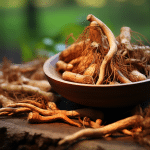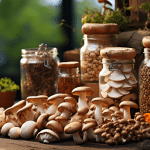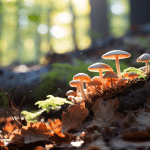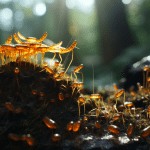Are Mushrooms Vegetables? How Are Mushrooms Classified?
No, mushrooms are fungi and not considered vegetables. Technically, mushrooms are not plants, and therefore are not classified as fruits or vegetables. They are in their own, distinct classification as fungus.
But, for practical purposes, in terms of the way that we cook them, we generally consider mushrooms as vegetables in the kitchen. In this post, I am going to explain what is a vegetable and also what is a mushroom. I will explain why, biologically speaking, mushrooms are not plants. But we often treat them like vegetables anyway, in cooking at least.
What Are The Classifications of a Vegetable?
All vegetables and fruits are from plants. Vegetables may be the specific parts of the plant it uses for reproduction. This is true for tomatoes, peppers, artichokes, cucumbers, eggplants, beans, peas, and many other vegetables and fruits. For other vegetables, we consume all or nearly all of the plant itself, as in the case of onions, spinach, lettuce, cauliflower, or celery.
The basic characteristic all plants share is that they collect energy from the sun and convert that to energy using the chlorophyll contained within their cells. Chlorophyll is what gives the vast majority of plants their distinctive green color.
What Is A Fungi?
Mushrooms are free of chlorophyll. They don’t convert sunlight to energy. Instead, they derive their needed nutrients from dead, rotting matter, or the roots system of living plants.
They are thus classified as a distinct kingdom called Fungi. Other members of the kingdom of fungi include yeasts and moulds.
Mycorrhizal mushrooms form symbiotic relationships with tree roots, which are still living. They take nutrients from trees, but also give back, and also help to build up a big, healthy root system for trees. Mushrooms that fall into this category include truffles, chanterelles, and porcini mushrooms.
Parasitic mushrooms live on live trees, but do not provide any food. They simply pull nutrients out of the tree until the tree finally dies.
Saprophytic mushrooms live off organic material, like dead trees after the parasitic mushrooms have killed them, plant roots, and fallen leaves. They draw minerals, carbon dioxide, and other nutrients from organic matter.
Some common saprophytes include oyster mushrooms, shiitake mushrooms, and white button or crimini mushrooms. The mushrooms that we eat are just a tiny fraction of all mushrooms. Underground, or within trees, mushrooms begin with a root system called mycelium, which is a white, fuzzy substance. This makes up the bulk of the mushroom, and much of its life is spent in this stage.
Learn more: Adaptogenic mushroom powder
Mycelium may remain hidden for years, until humidity, temperature, and other factors are right, then it creates a mushroom. Mushrooms are a type of fruit that is produced by the fungus. They grow up and then split open, which releases the spores, basically the seeds of the fungus. These spores fall down or are carried in by wind, and start growing another mycelium colony elsewhere.
Are Mushrooms Considered A Fruit?
If mushrooms are not biologically vegetables, it stands to reason they are not fruits, too, right? While mushrooms aren’t technically fruits, they’re closer to fruiting vegetables.
The mushrooms that we know and love are actually tiny pieces of the far larger, living, growing portion of mushrooms called the mycelium, which grows beneath the soil or on logs. The mushrooms that you see are the reproductive parts of the fungus. Their purpose is to grow and propagate the reproductive parts of the fungus. These are called spores, and they are basically a mushrooms seeds.
So, mushrooms are sort of like fruits, in this respect. The only difference is they are not produced by plants, nor do they need the pollination or flowers usually necessary for fruits to grow in the plant world.
How Mushrooms Are Used for Culinary Purposes
Do mushrooms count as vegetables when we are cooking them? When we consider mushrooms in a kitchen, for practical purposes, they are considered vegetables. We prepare mushrooms much like we prepare vegetables.
We can put the science to one side when we are cooking. Technically, tomatoes and peppers are fruits too, but we generally think of them as vegetables for cooking purposes. When trying to make a dish, what makes something taste good is much more important than technical details about its biology or how it replicates.
While mushrooms are cooked as vegetables, they can also be an excellent meat substitute because of their meaty texture and flavorful flavor. A big cap of a portobello makes an excellent substitute for beef hamburger patties, and sliced into strips the size of a pinky is perfect finger food for kids, or you can shred mushrooms to use as meat in tacos, chili, or a variety of other dishes. Here, you can find 30 of the best mushroom recipe ideas, along with several ways to prepare them.
Learn more: Growing mushrooms from grain spawn
More On ‘Kingdom’ Classification in Biology
It is important to point out that the Kingdom of Life in biology is made by humans. They are not absolute facts of nature. Instead, they are simply the way scientists classify the various life forms on our planet, for convenience. We converge on certain characteristics that divide various lifeforms, in order to decide to what realm they belong.
In fact, prior to 1969, mushrooms were considered to be an early member of the Kingdom of plants. Previously, only four Kingdoms of Life existed: Monera, Protista, Plantae, and Animalia. In 1969, Robert Harding Whittaker proposed the fifth Kingdom, the Kingdom of Fungi.
This taxonomic system is continually changing and being updated. As of 2015, scientists now categorize life in seven Kingdoms: Bacteria, Archaea, Protozoa, Chromista, Plantae, Fungi, and Animalia. Because of the number of Fungi species present, giving them their own kingdom was necessary to help categorize them and to separate them from plants. But in reality, nature does not make that distinction, and it is common for the lines between what is a plant, an animal, or a fungus to be blurred.
For instance, consider predatory plants such as Venus flytraps, which can literally catch and eat insects, or even smaller animals such as frogs. Plants have chlorophyll, and they use photosynthesis to convert sunlight into food of their own. They usually have leaves and roots, and cannot move as animals can. Animals ingest their food, which is typically another plant or animal, sometimes a fungus. They take in oxygen and exhale carbon dioxide, unlike plants and fungi, which do the reverse.
Animals also tend to have a lot more locomotion, or motion, than plants or fungi. Fungi derive nutrients from the decomposing matter of plants or animals in the wild, as they do not possess chlorophyll. Fungi also do not have cellulose, which is found in plants sold for sale. Instead, they contain chitin, the same substance found in insect and shellfish. They do not have leaves, roots, or seeds, nor do they require light for growth.















